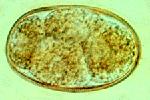Difference between revisions of "Ancylostomatoidea"
Jump to navigation
Jump to search
(Redirected page to Category:Ancylostomatoidea) |
m |
||
| (One intermediate revision by one other user not shown) | |||
| Line 1: | Line 1: | ||
| − | # | + | {{unfinished}} |
| + | |||
| + | {{toplink | ||
| + | |backcolour = | ||
| + | |linkpage =Parasites | ||
| + | |linktext =PARASITES | ||
| + | |pagetype=Bugs | ||
| + | |sublink1=Nematodes | ||
| + | |subtext1=NEMATODES | ||
| + | }} | ||
| + | <br> | ||
| + | |||
| + | == General Appearance == | ||
| + | [[Image:Ancylostoma.jpg|thumb|right|150px|''Ancylostoma'' - Courtesy of the Laboratory of Parasitology, University of Pennsylvania School of Veterinary Medicine]] | ||
| + | *Like the Strongyloidea, except the head is bent dorsally. | ||
| + | *All have a large buccal cavity with teeth and/or cutting plates. | ||
| + | *Some also have teeth and/or cutting plates around the mouth. | ||
| + | |||
| + | |||
| + | == General Life-Cycle == | ||
| + | Like that of the Strongyloidea, but infection can be by ingestion and/or skin penetration. | ||
| + | |||
| + | |||
| + | |||
| + | |||
| + | |||
| + | |||
| + | |||
| + | *''Ancylostoma'' in [[Muscles Inflammatory - Pathology#Nematodes|myositis]] | ||
| + | *''Ancylostoma'' and ''Uncinaria'' in [[Parasitic skin infections - Pathology#Hookworms|skin infections]] | ||
Revision as of 13:58, 23 December 2008
| This article is still under construction. |
|
|
General Appearance
- Like the Strongyloidea, except the head is bent dorsally.
- All have a large buccal cavity with teeth and/or cutting plates.
- Some also have teeth and/or cutting plates around the mouth.
General Life-Cycle
Like that of the Strongyloidea, but infection can be by ingestion and/or skin penetration.
- Ancylostoma in myositis
- Ancylostoma and Uncinaria in skin infections
